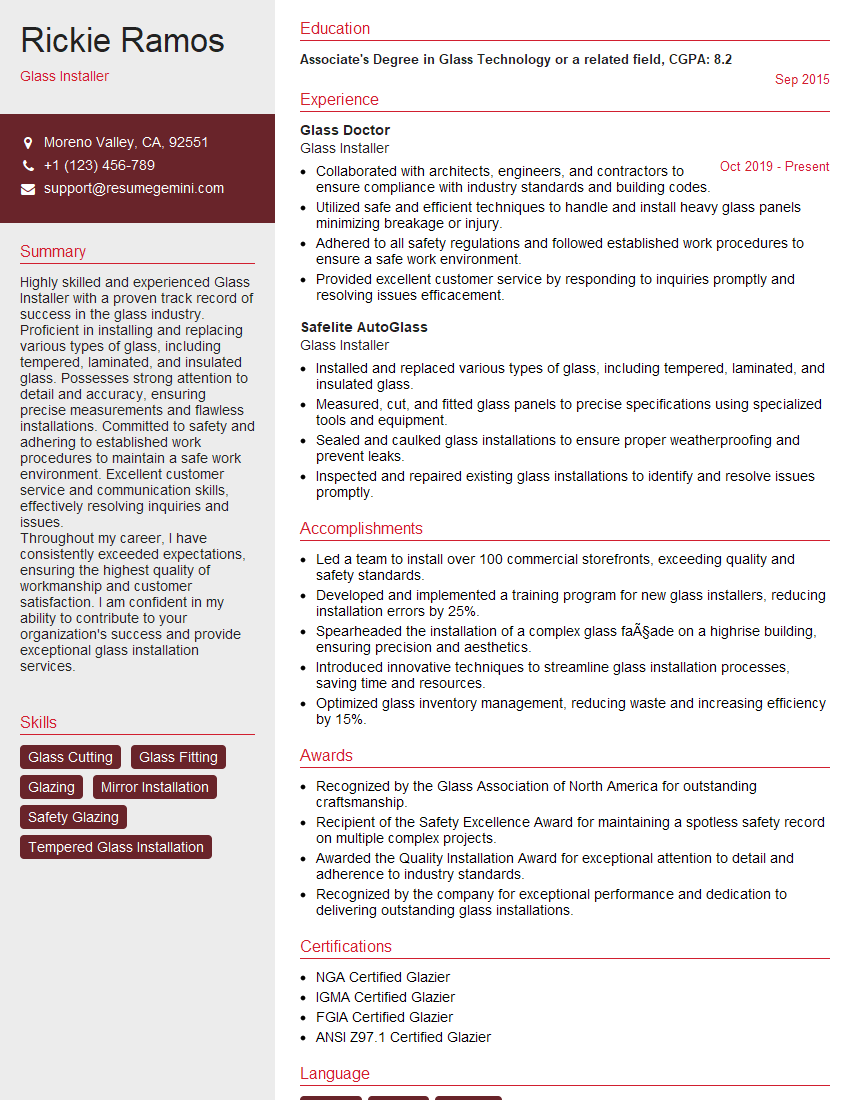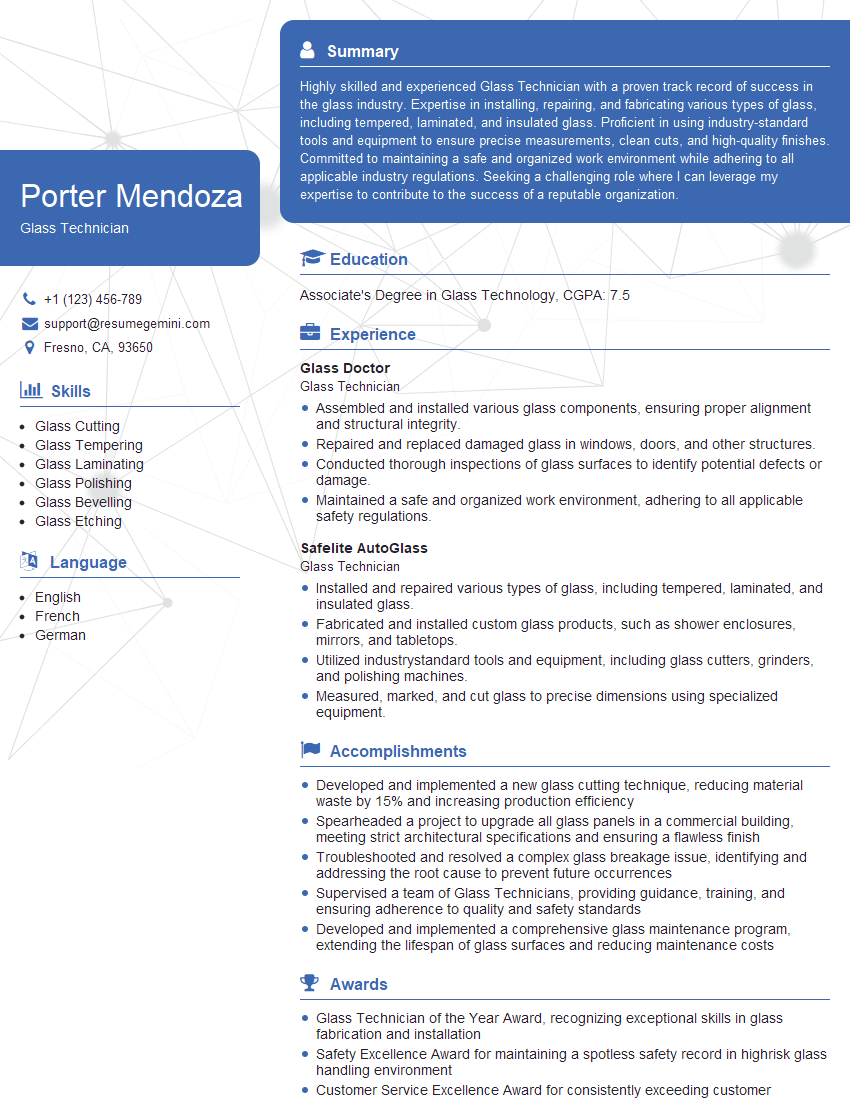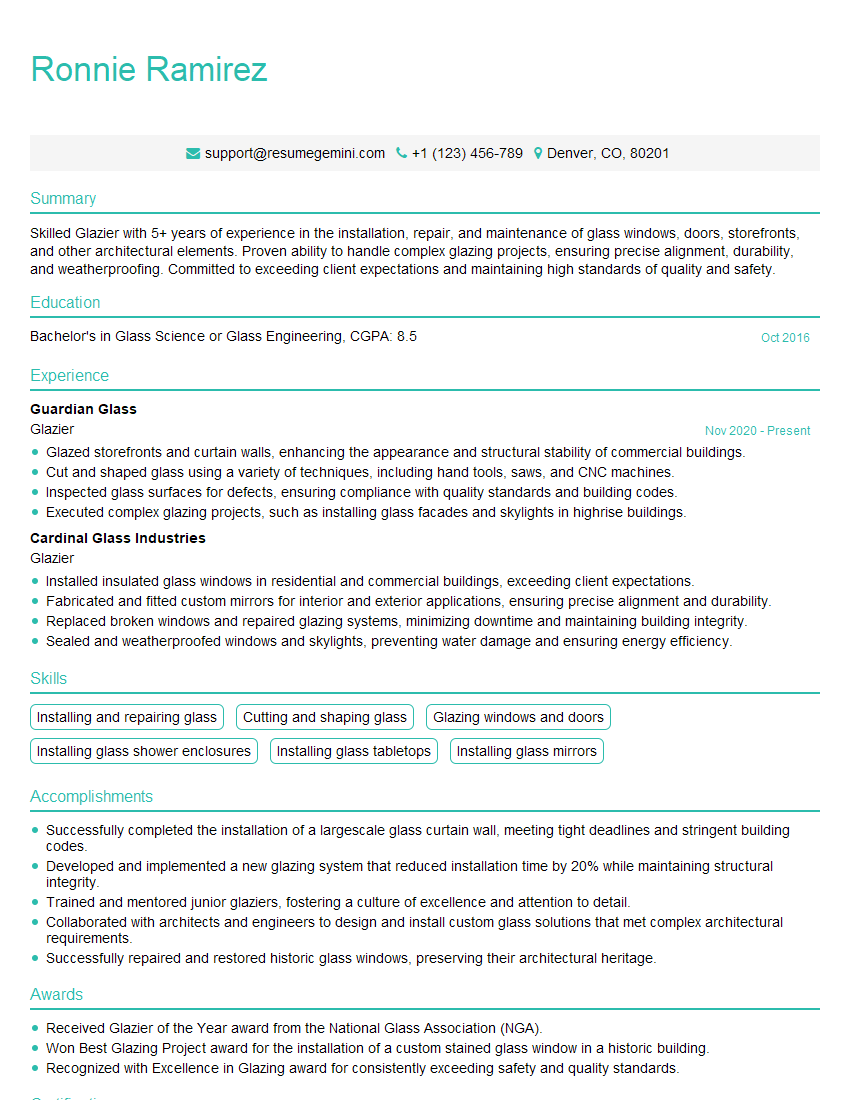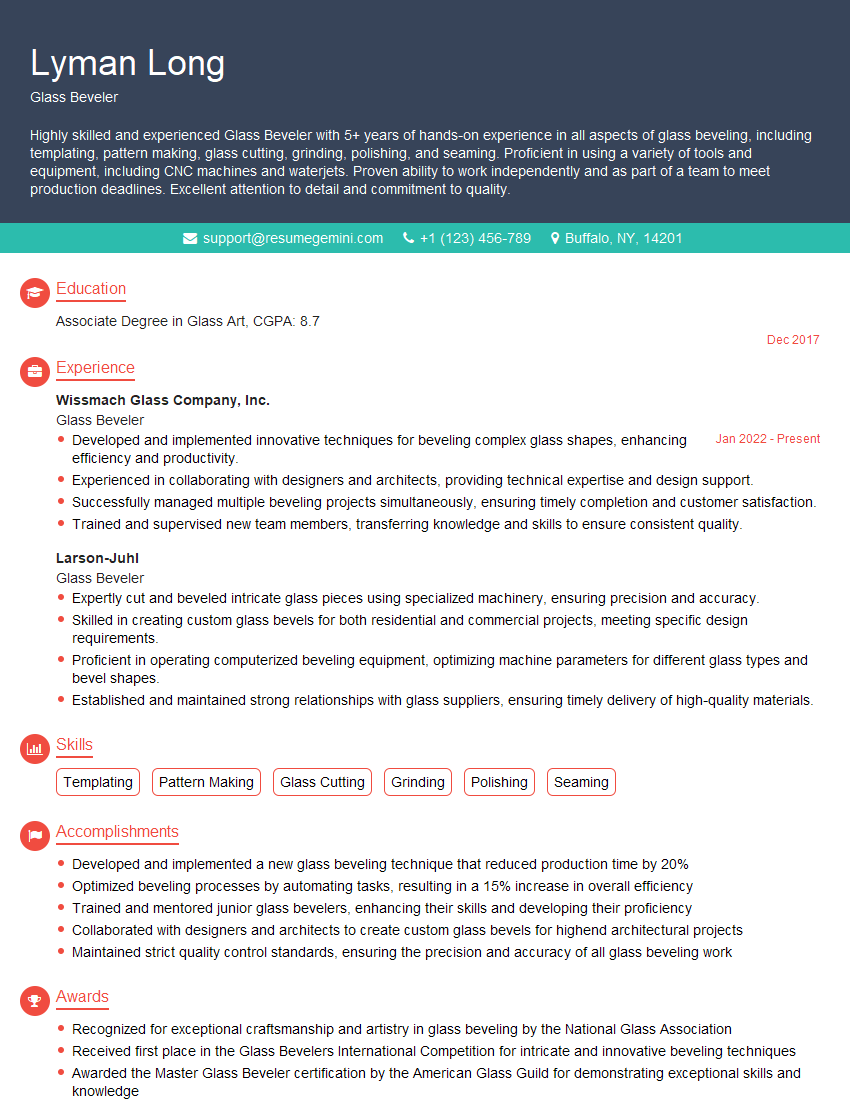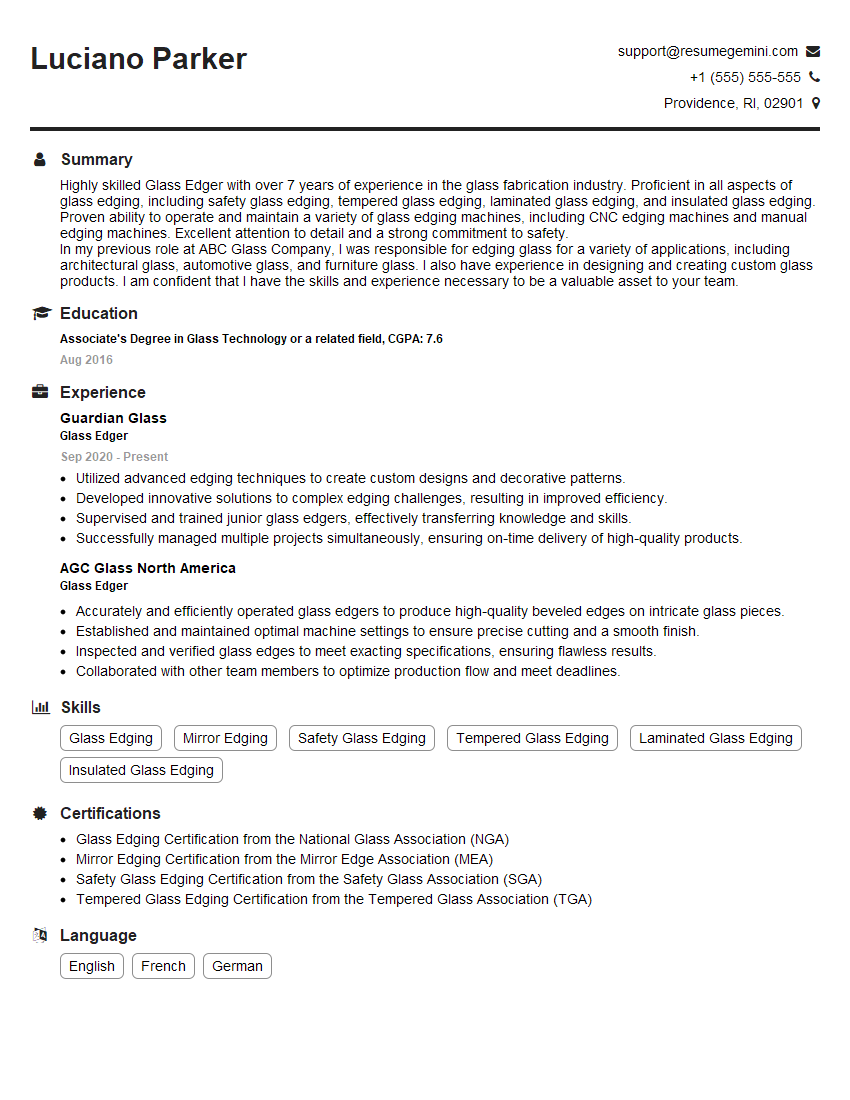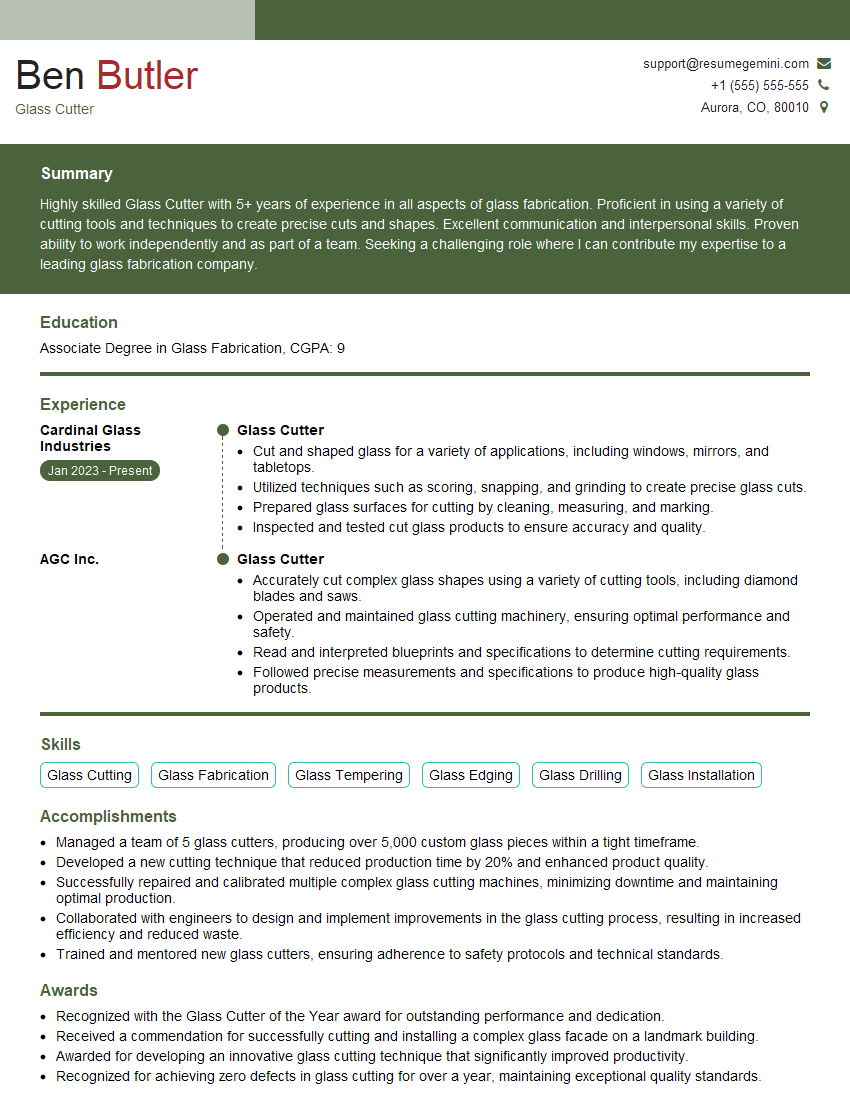Every successful interview starts with knowing what to expect. In this blog, we’ll take you through the top Breaking glass to size interview questions, breaking them down with expert tips to help you deliver impactful answers. Step into your next interview fully prepared and ready to succeed.
Questions Asked in Breaking glass to size Interview
Q 1. What types of glass are most challenging to cut to size and why?
Some glass types are significantly more challenging to cut to size than others. This difficulty stems primarily from their material properties and composition. Tempered glass, for instance, is notoriously difficult because it undergoes a heat-treating process that creates internal stresses. Attempting to cut it often results in shattering, rendering it unusable. Laminated glass, consisting of multiple layers bonded together, also presents a challenge. The multiple layers and the interlayer material complicate the cutting process and require specialized tools and techniques. Finally, certain specialty glasses, like those with embedded wires or coatings, require careful consideration and specialized tools to avoid damage to the underlying components.
Imagine trying to cut a tightly wound spring – the internal stresses make it highly likely to break unexpectedly. Tempered glass is similar. It’s incredibly strong but inherently unstable once the surface is compromised.
Q 2. Describe your experience with different glass cutting tools (e.g., manual, automated).
My experience encompasses a wide range of glass cutting tools, from basic manual tools to sophisticated automated systems. I’ve extensively used manual glass cutters, which rely on a hardened wheel to score the glass. This technique requires precision and a steady hand. I’ve also worked with electric glass cutters that provide more consistent scoring, especially for thicker glass. In my experience with automated systems, such as CNC glass cutting machines, the precision and speed are unparalleled, enabling highly complex cuts and shapes with exceptional accuracy. Each tool has its strengths and limitations, and the choice depends heavily on the type of glass, the desired cut, and the volume of work. For instance, manual cutting is best suited for small, simple projects where precise control is crucial, while automated systems excel in high-volume production environments needing intricate cuts.
I remember one instance where I was working on a large-scale project involving hundreds of custom-shaped glass panels. The manual method would have been impossibly time-consuming and prone to errors. The automated CNC cutter allowed us to complete the project efficiently and accurately, meeting the tight deadline.
Q 3. How do you ensure accurate measurements before cutting glass?
Accurate measurement is paramount in glass cutting. Inaccuracy leads to wasted material and potentially unusable pieces. I always begin by meticulously measuring the required dimensions using precise measuring tools, typically a steel ruler and a square. For complex shapes, I employ templates or digital design software to create accurate patterns. Once the measurements are taken, I double-check them to avoid costly mistakes. In the case of curved glass, specialized tools and techniques such as flexible measuring tapes might be necessary. The measurement process should always prioritize accuracy and consistency to ensure the final product meets specifications.
I recall a situation where a slight measurement error in a large glass window panel led to significant rework and delays. This experience highlighted the importance of meticulous and repeated measurements to ensure precision.
Q 4. What safety precautions do you take when cutting glass?
Safety is paramount when working with glass. I always use safety glasses to protect my eyes from flying fragments. I also wear gloves to protect my hands from sharp edges and to provide a better grip. The cutting area must be clean and free from obstructions to prevent accidental trips or falls. After scoring the glass, I always support the piece firmly to prevent it from breaking unexpectedly during the snapping process. Further, I dispose of glass scraps carefully in designated containers, adhering strictly to all safety regulations and company protocols.
It’s like working with a very sharp knife – proper technique and safety precautions are essential to avoid injury.
Q 5. Explain your process for handling and storing cut glass to prevent damage.
Proper handling and storage of cut glass are vital to prevent damage and maintain quality. Cut glass pieces are carefully handled to avoid chipping or scratching the edges. They’re typically laid flat on a soft, padded surface, and if stacked, are separated by protective layers to prevent rubbing or breakage. Storage areas are clean and dry, free from dust and debris that can scratch the glass. For larger or more delicate pieces, I might use specialized protective packaging or cradles to prevent damage during transportation or storage. Proper storage ensures the longevity and integrity of the cut glass, maintaining its quality for its intended use.
Think of it like handling a piece of fine art – delicate care is required at every stage to maintain its pristine condition.
Q 6. How do you deal with glass breakage during the cutting process?
Breakage during the cutting process is an unavoidable risk, even with experience. If a piece breaks during scoring or snapping, I carefully examine the cause of the breakage – was it due to a flaw in the glass, an improper cutting technique, or a tool malfunction? Depending on the extent of the damage, I might try to salvage usable portions of the glass or start again with a new piece. The goal is to minimize waste and ensure that the final product meets the required quality standards. Accurate assessments and appropriate actions are crucial to managing unexpected problems and maintaining productivity.
It’s crucial to learn from these occurrences, so the same mistakes aren’t repeated.
Q 7. What are the common causes of inaccuracies in glass cutting?
Inaccuracies in glass cutting stem from several sources. Improper measurements, using blunt or poorly maintained cutting tools, inconsistent scoring pressure, and an unsteady hand during the snapping process are all common culprits. External factors such as temperature fluctuations and variations in the glass itself (e.g., inconsistencies in thickness) can also introduce inaccuracies. To minimize errors, it is important to use proper equipment, maintain a consistent cutting technique, regularly inspect and maintain tools, and account for external factors that can affect the outcome.
Imagine trying to draw a perfect line with a dull pencil – the result will inevitably be imprecise. Similarly, dull or faulty tools can compromise the precision of the glass cut.
Q 8. Describe your experience with different types of glass cutting techniques.
My experience encompasses a wide range of glass cutting techniques, from traditional hand methods to advanced automated systems. I’m proficient in using various tools, including:
- Manual Glass Cutters: These utilize a hardened wheel to score the glass, followed by snapping along the score line. I’m adept at controlling the pressure and scoring depth for different glass types and thicknesses. For instance, a lighter touch is needed for thinner glasses to avoid shattering.
- Electric Glass Cutters: These offer more precise and consistent scoring, particularly beneficial for intricate cuts or mass production. I’ve worked with both oil-fed and dry electric cutters, understanding their specific maintenance needs.
- Waterjet Cutting: This method uses a high-pressure stream of water to cut through the glass, ideal for complex shapes and various materials. I have experience optimizing parameters like pressure and nozzle size for achieving clean, precise cuts with minimal chipping.
- Laser Cutting: I’m familiar with laser cutting systems, which provide exceptional precision and speed, especially for intricate designs and mass production. This method requires understanding the laser’s power and settings to prevent damage or discoloration.
Each technique demands a different skill set, and I’ve honed my abilities across all of them, adapting my approach based on the project’s specifications and the glass type.
Q 9. How do you determine the appropriate cutting tool for a specific type of glass?
Selecting the right cutting tool depends heavily on several factors: the type of glass, its thickness, the desired cut complexity, and the volume of work.
- Glass Type: Annealed glass, tempered glass, laminated glass, and specialty glasses like borosilicate all have different properties impacting the choice of cutting tool. Tempered glass, for example, is very difficult to cut and often requires specialized tools or scoring methods.
- Thickness: Thicker glasses necessitate more robust tools capable of handling the increased material resistance. A manual cutter might suffice for thin glass, but a waterjet or laser cutter would be necessary for thicker pieces.
- Complexity: Intricate designs or curved cuts generally call for automated systems like waterjet or laser cutters, which can handle intricate geometries with precision. Manual cutters are better suited to simpler, straight cuts.
- Volume: For mass production, automated systems like CNC-controlled glass cutters offer efficiency and consistency unmatched by manual methods.
Consider this analogy: choosing a saw to cut wood. A hand saw works for small jobs, but a power saw is needed for larger projects. Similarly, glass cutting tool selection involves matching the tool’s capabilities to the project’s requirements.
Q 10. What is your experience with automated glass cutting machines?
My experience with automated glass cutting machines is extensive. I’ve operated and maintained various CNC (Computer Numerical Control) glass cutting systems, including those employing scoring wheels, waterjet, and laser technologies. I’m proficient in programming these machines, optimizing cutting parameters, and troubleshooting malfunctions.
For instance, I’ve worked with machines that use CAD (Computer-Aided Design) software to generate cutting paths, ensuring optimal material utilization and minimizing waste. I understand the importance of calibrating the machine regularly to maintain accuracy and precision, and I’m well-versed in preventative maintenance procedures to minimize downtime.
Automated systems significantly enhance productivity and precision, especially in large-scale projects. However, they require a different level of technical expertise compared to manual cutting methods, and my skills bridge this gap effectively.
Q 11. How do you troubleshoot malfunctions in glass cutting equipment?
Troubleshooting malfunctions in glass cutting equipment requires a systematic approach. It begins with identifying the symptom – for example, inaccurate cuts, broken scoring wheels, or machine malfunctions – and then investigating potential causes.
My troubleshooting strategy includes:
- Visual Inspection: A thorough visual inspection to identify any obvious problems, like damaged components or loose connections.
- Diagnostics: Using built-in diagnostics or error codes to pinpoint the source of the problem.
- Calibration Checks: Verifying calibration settings to ensure the machine is properly aligned and functioning within its specifications.
- Component Checks: Testing individual components (e.g., motors, pumps, sensors) to determine if they are functioning correctly.
- Software Review: Examining the machine’s software settings and programming for potential errors or inconsistencies.
For example, if the cuts are consistently off, I would check the machine’s calibration, the sharpness of the scoring wheel, and the accuracy of the programmed cutting path. Documentation and record-keeping are critical during troubleshooting to efficiently identify and resolve issues in the future.
Q 12. Describe your experience with quality control procedures for cut glass.
Quality control is paramount in glass cutting. My experience involves implementing and adhering to rigorous quality control procedures throughout the entire process, from material selection to final inspection.
Key aspects of my quality control procedures include:
- Material Inspection: Careful examination of the glass sheets for defects like scratches, bubbles, or inconsistencies before cutting.
- Process Monitoring: Regular monitoring of the cutting process to ensure consistent performance and identify potential problems early on.
- Dimensional Accuracy: Precise measurement of cut pieces to verify that they meet the required specifications using calibrated tools.
- Edge Quality: Inspection of the cut edges for smoothness, chipping, or breakage. This often involves visual inspection and sometimes microscopic examination.
- Documentation: Maintaining detailed records of materials used, cutting parameters, and inspection results. This creates a traceable audit trail for quality assurance.
Failure to follow these procedures can lead to significant costs and time losses from rejected products. Thus, a commitment to quality control is crucial for efficient and successful glass cutting operations.
Q 13. How do you ensure the smooth edges and surface quality of the cut glass?
Achieving smooth edges and high surface quality is a critical aspect of glass cutting. It’s not just about the initial cut; post-processing plays a significant role.
Methods for ensuring smooth edges and surface quality include:
- Proper Scoring: Consistent and precise scoring is fundamental. Too much pressure can lead to chipping, while too little results in incomplete breaks.
- Controlled Snapping: Careful snapping techniques minimize chipping and breakage. Using specialized tools and techniques can help.
- Edge Grinding and Polishing: For applications demanding exceptional smoothness, edge grinding and polishing are crucial steps. These processes remove any irregularities left after cutting.
- Automated Finishing Systems: Automated edge-grinding and polishing machines ensure consistency and efficiency, particularly in high-volume operations.
Think of it like woodworking – a rough cut needs sanding and finishing to achieve a smooth, polished surface. Similarly, post-cutting processes in glass cutting are essential for obtaining the desired quality.
Q 14. How do you handle different thicknesses of glass?
Handling different glass thicknesses requires adapting techniques and equipment. Thicker glass presents greater challenges, demanding more force and potentially specialized tools.
My approach to handling varying thicknesses includes:
- Tool Selection: Using appropriate cutting tools – manual cutters for thinner glass, waterjet or laser cutters for thicker glass.
- Scoring Pressure: Adjusting the scoring pressure based on the glass thickness. More pressure is needed for thicker glass to ensure a complete score.
- Snapping Technique: Modifying snapping techniques based on thickness. Thicker glass might require additional support to prevent breakage during the snapping process.
- Lubrication: Using lubrication (e.g., oil) to reduce friction and prevent chipping, especially for thicker pieces.
- Automated Support: Utilizing automated systems with adjustable cutting parameters for optimal handling of different thicknesses.
The analogy of cutting through different thicknesses of wood applies here. A thin piece of wood requires less force than a thicker piece; the same principle holds for glass cutting. Adaptability and precision are vital in successfully handling a range of glass thicknesses.
Q 15. What are the common types of glass used in construction?
Construction glass comes in various types, each with unique properties. The most common include:
- Annealed Glass (Float Glass): This is the standard, basic type. It’s relatively inexpensive and easy to cut, but it shatters into sharp, unpredictable pieces when broken. Think of the typical window glass in your home.
- Tempered Glass (Safety Glass): This is heat-treated to increase strength and shatter resistance. When broken, it crumbles into small, relatively harmless granules, making it safer than annealed glass. Commonly used in car windshields and shower doors.
- Laminated Glass: This consists of two or more layers of glass bonded together with a layer of polyvinyl butyral (PVB) interlayer. This interlayer holds the glass together even when shattered, providing significant safety and security. Often used in car windshields and hurricane-resistant windows.
- Insulated Glass Units (IGUs): These are two or more panes of glass separated by a spacer filled with desiccant and inert gas (like argon or krypton) to improve insulation and energy efficiency. Cutting IGUs requires specialized techniques.
- Specialty Glass: This encompasses a wide range of glasses with enhanced properties, like low-iron glass for clearer views, patterned glass for privacy, or coated glass for energy efficiency. Cutting these can require specific tools and approaches.
Career Expert Tips:
- Ace those interviews! Prepare effectively by reviewing the Top 50 Most Common Interview Questions on ResumeGemini.
- Navigate your job search with confidence! Explore a wide range of Career Tips on ResumeGemini. Learn about common challenges and recommendations to overcome them.
- Craft the perfect resume! Master the Art of Resume Writing with ResumeGemini’s guide. Showcase your unique qualifications and achievements effectively.
- Don’t miss out on holiday savings! Build your dream resume with ResumeGemini’s ATS optimized templates.
Q 16. What is your experience with beveling or edging glass?
Beveling and edging are crucial finishing processes that enhance the aesthetic appeal and functionality of glass. I have extensive experience with both, using a variety of machines, including automated beveling machines and hand-held grinders. My expertise extends to various bevel profiles—from simple chamfers to elaborate sculpted edges. I’m proficient in creating both straight and curved edges, adjusting the bevel width and angle according to the project’s specifications. I meticulously ensure precision and consistency in the finishing to meet high-quality standards. I understand the importance of using appropriate safety equipment during these processes, including eye protection and dust masks.
Q 17. Describe your understanding of glass tempering and its impact on cutting.
Tempered glass is significantly stronger than annealed glass due to a heat-treating process. This process involves heating the glass to a high temperature and then rapidly cooling it. This creates compressive stresses on the surface and tensile stresses in the interior. The impact of this on cutting is substantial: tempered glass is far more difficult and dangerous to cut. Standard glass cutters often fail to score it effectively, and attempts to break it along the score line often result in unpredictable shattering. Specialized tools and techniques are required, and safety precautions are paramount due to the potential for uncontrolled breakage into sharp fragments. For repairs or modifications, tempered glass is generally replaced rather than cut.
Q 18. What is your understanding of laminated glass and its cutting process?
Laminated glass, as mentioned before, comprises multiple layers of glass bonded with a PVB interlayer. Cutting laminated glass requires careful consideration to avoid damaging the interlayer or causing delamination (separation of layers). I typically use a diamond-tipped glass cutter to score the glass multiple times, ensuring a clean cut through all layers. The scoring needs to be precise and consistent to avoid chipping or fracturing. Snapping the glass requires a controlled approach to prevent the interlayer from stretching or tearing. Post-cutting, I carefully inspect the edges to ensure there are no loose fragments or delamination to maintain the structural integrity and safety of the finished product.
Q 19. How do you handle special requests or custom glass cutting projects?
Handling special requests and custom projects is a regular part of my work. This involves close collaboration with clients to understand their vision, then translating their specifications into precise cutting plans. I meticulously measure and mark the glass, ensuring accuracy and minimizing waste. For complex shapes or designs, I utilize templates or CAD drawings to guide the cutting process. I always discuss potential challenges and limitations with the client upfront, ensuring realistic expectations are set and a mutually agreeable solution is reached. Safety and precision remain my top priorities, no matter the complexity of the project.
Q 20. Describe a time you had to adapt your cutting techniques to overcome a challenge.
I once had to cut a large piece of curved, laminated glass for a museum display case. The curve was complex and the laminated layers made it exceptionally challenging to score and snap cleanly. Standard methods resulted in chipping and fracturing. To overcome this, I researched alternative scoring techniques, finding success using a specialized curved glass cutter along with a controlled water-jetting process to assist the break. The combination of the specialized tools and technique allowed me to achieve a clean, chip-free cut, ensuring the finished product met the high standards required for the museum display.
Q 21. What is your knowledge of different glass scoring methods?
Several scoring methods are employed for different glass types and project requirements:
- Manual Scoring: This involves using a handheld glass cutter with a diamond or carbide wheel to score the glass surface. This is widely used for annealed glass, requiring a firm, even pressure for a clean score.
- Automated Scoring: This utilizes specialized machinery for high-volume or precise cutting, often found in industrial settings. It offers greater speed and consistency than manual scoring.
- Waterjet Cutting: A high-pressure water jet is used to precisely cut the glass, ideal for intricate designs and curved cuts. It is less prone to chipping and fracturing compared to traditional scoring, particularly for thicker or stronger glass types like tempered or laminated glass.
- Laser Cutting: Laser cutting offers exceptional precision and can cut through a wide array of glass types, but is typically more expensive than other methods and requires specialized equipment.
The choice of scoring method depends heavily on the type of glass, desired precision, and project scale. Safety considerations are paramount regardless of the chosen technique.
Q 22. Explain the importance of using the right type of cutting oil or lubricant.
The right cutting oil or lubricant is absolutely crucial for precise and clean glass breaks. It acts as a lubricant, reducing friction between the cutting wheel and the glass surface. This minimizes chipping, cracking, and the dreaded ‘spider-webbing’ effect, resulting in a smoother, more accurate cut. Different glasses require different lubricants; for instance, annealed glass might work well with a simple kerosene-based oil, while tempered or specialty glasses may need specialized solutions to prevent thermal shock during the cutting process.
Imagine trying to cut a piece of wood without lubrication – it would be difficult and likely result in a ragged cut. The same principle applies to glass. A good quality lubricant ensures the cutting wheel glides smoothly across the surface, allowing for a clean break along the scored line. Poor lubrication, on the other hand, can lead to uneven cuts, wasted material, and potentially damaged tools.
- Type of Glass: The type of glass dictates the appropriate lubricant. Harder, more resistant glasses may require a more viscous lubricant.
- Cutting Tool: Different cutting tools may have specific lubricant recommendations.
- Environmental Conditions: Humidity and temperature can influence the choice of lubricant. A thicker lubricant might be beneficial in humid environments.
Q 23. How do you maintain the sharpness and condition of your glass cutting tools?
Maintaining the sharpness and condition of glass cutting tools is paramount for consistent, high-quality cuts. This involves a multi-faceted approach focusing on both cleaning and storage.
- Regular Cleaning: After each use, the cutting wheel should be thoroughly cleaned to remove any glass dust or debris. A soft brush and a suitable cleaning solvent can be used for this purpose. Leaving residue on the wheel can dull its edge and negatively impact cutting precision.
- Proper Storage: When not in use, tools should be stored in a safe, dry place, away from dust and moisture. A protective case or cover can help prevent damage and corrosion.
- Sharpening: While some cutting wheels are disposable, others can be sharpened using specialized diamond sharpening tools. This is best performed by a professional or with specific training, as improper sharpening can damage the wheel. Regular inspection allows for timely sharpening, preventing further wear.
- Inspection: Frequent visual inspection allows identification of damage or wear, enabling proactive maintenance, extending the lifespan of the tool, and preventing costly errors.
Imagine a dull knife struggling to cut through a tomato – it’s frustrating and results in an uneven, messy cut. Keeping your glass cutting tools sharp is equally crucial for achieving a clean, precise cut every time.
Q 24. What are the key factors that affect the quality of a glass cut?
Several key factors influence the quality of a glass cut. These factors, often interconnected, determine whether the final product meets the required standards of precision and visual appeal.
- Scoring Depth: An insufficiently deep score results in an uneven break, while too deep a score can cause chipping or cracking. The right depth ensures a clean separation.
- Cutting Wheel Condition: A dull or damaged cutting wheel creates uneven scores, leading to imprecise cuts and potential breakage.
- Lubrication: The use of appropriate and sufficient lubrication reduces friction, allowing for a cleaner and more controlled break.
- Glass Type: Different types of glass (e.g., annealed, tempered, laminated) have varying hardness and breakage properties, requiring adjusted techniques.
- Scoring Pressure: Applying too much pressure while scoring can damage the glass, while too little pressure leads to an incomplete score. Consistent, controlled pressure is essential.
- Breaking Technique: Using the correct breaking technique, whether applying even pressure to the score or using a specialized tool, is crucial for a clean break.
- Environmental Factors: Temperature and humidity can affect glass breakage properties. Extreme conditions may require adjustments to cutting techniques.
Think of baking a cake – the quality of the final product depends on precise measurements, the right ingredients, and the correct baking technique. Similarly, high-quality glass cuts are the result of carefully controlling all the factors involved.
Q 25. Describe your experience with different types of glass breakage and how to prevent them.
My experience encompasses various types of glass breakage, each with unique causes and prevention strategies. Understanding these is crucial for minimizing waste and ensuring safety.
- Chipping: Often caused by insufficient lubrication, dull cutting tools, or excessive pressure during scoring and breaking. Prevention involves using sharp tools, adequate lubrication, and controlled pressure.
- Cracking: Can stem from internal stresses in the glass (tempered glass is particularly prone), improper scoring depth, or impact damage. Prevention involves careful handling, correct scoring depth, and selecting the appropriate glass type for the application.
- Spider-webbing: This characteristic radial cracking originates from a point of impact or a flawed score. It’s often caused by inadequate lubrication or applying pressure at the wrong point during breakage. Prevention involves using proper lubrication, precise scoring techniques, and selecting high-quality glass free from defects.
- Thermal Breakage: This is often a result of rapid temperature changes, particularly in tempered glass. Prevention involves controlling the environment during the cutting and handling process and avoiding exposure to sudden temperature fluctuations.
I’ve learned that anticipating potential breakage points and employing preventative measures is much more cost-effective than dealing with broken glass and material waste. It’s a combination of experience, knowledge of materials, and consistent adherence to proper techniques.
Q 26. How do you calculate the material waste and optimize glass usage?
Calculating material waste and optimizing glass usage is a crucial aspect of efficient glass cutting. This involves careful planning and the use of effective software tools.
Firstly, I meticulously review the project requirements to determine the precise dimensions needed for each glass piece. Then, I use nesting software (discussed in the next answer) to optimize the layout of the cuts on the glass sheets. This software helps minimize waste by arranging the pieces in a way that maximizes the usage of each sheet.
Regularly, I track the amount of waste generated in each project. This data allows me to identify areas for improvement in the cutting process. For example, I might adjust the nesting parameters or explore alternative cutting patterns to reduce waste. The goal is always to minimize waste, which not only reduces costs but also contributes to environmentally friendly practices.
Visualizing the layout before cutting is crucial, so I often create mock-ups to further refine the cutting plan. This additional step significantly reduces the risk of errors and ensures maximum material utilization.
Q 27. What software or systems have you used for measuring and planning glass cuts?
Throughout my career, I’ve utilized several software and systems for measuring and planning glass cuts. These range from simple CAD programs to advanced nesting software.
- CAD Software: Programs like AutoCAD or similar allow for precise measurements and the creation of detailed drawings, facilitating accurate planning.
- Nesting Software: Specialized nesting software, such as Cut Rite or similar, automates the process of arranging glass pieces on sheets to minimize waste. These programs analyze the required cuts and provide an optimized layout.
- Digital Measuring Tools: I frequently use digital calipers and laser measuring tools to ensure accurate measurements before and during the cutting process.
For example, in a recent project involving hundreds of custom-sized glass panels, I used nesting software to optimize the layout, resulting in a significant reduction in material waste (approximately 15%). The software’s capabilities in automatically generating cutting patterns and providing detailed material usage reports greatly enhanced efficiency and accuracy.
Q 28. How would you approach a large-scale glass cutting project?
Approaching a large-scale glass cutting project requires a systematic and organized approach to ensure efficiency and accuracy. This involves meticulous planning, careful execution, and consistent quality control.
- Detailed Project Planning: Begin with a thorough review of project specifications, including dimensions, quantities, glass type, and tolerances. This phase also includes selecting the appropriate cutting tools and lubricants.
- Material Acquisition: Secure sufficient quantities of the required glass type, considering potential breakage and waste. Ensure the material is of consistent quality and free from defects.
- Cutting Optimization: Employ nesting software or advanced layout techniques to optimize the placement of cuts on the glass sheets, minimizing waste.
- Teamwork and Communication: Large projects typically involve a team. Establish clear communication channels to ensure everyone understands their roles and responsibilities.
- Quality Control: Implement rigorous quality control measures throughout the process, inspecting each cut for accuracy and adherence to specifications.
- Waste Management: Develop a plan for handling and disposing of glass waste in an environmentally responsible manner.
- Project Tracking: Monitor project progress, identify potential issues, and make adjustments as needed to ensure timely completion.
A recent large-scale project involved creating custom glass panels for a high-rise building. By meticulously following this plan, we managed to deliver the project on time and within budget, minimizing waste and maintaining a high standard of quality.
Key Topics to Learn for Breaking glass to size Interview
Success in interviews focusing on “Breaking glass to size” (assuming this refers to a specialized skill or process within a particular industry, like material science, manufacturing, or engineering) requires a multi-faceted approach. Understanding the theoretical underpinnings is as crucial as demonstrating practical application and problem-solving capabilities.
- Material Properties and Selection: Understanding the properties of various materials and how they behave under stress and impact is fundamental. Consider factors like brittleness, fracture toughness, and yield strength.
- Fracture Mechanics: Explore the theoretical concepts of crack initiation and propagation. This includes understanding stress concentration, crack growth mechanisms, and fatigue.
- Sizing Techniques and Methods: Investigate different methods for precisely controlling the size and shape of broken pieces. This might include controlled fracturing techniques, laser cutting, or other specialized methods. Consider the precision and tolerances required.
- Quality Control and Inspection: Learn about quality control measures and inspection techniques used to ensure the broken pieces meet specified size requirements and quality standards. This may involve visual inspection, dimensional measurements, or other non-destructive testing (NDT) methods.
- Safety Procedures and Regulations: Understand the safety protocols and regulatory compliance associated with handling glass and performing breakage operations. This is critical for ensuring a safe working environment.
- Troubleshooting and Problem-Solving: Develop your ability to identify and solve problems related to inconsistent breakage, material defects, or equipment malfunctions. Practice analyzing scenarios and proposing solutions.
Next Steps
Mastering the intricacies of “Breaking glass to size,” regardless of the specific industry context, significantly enhances your career prospects. It demonstrates a unique skill set and problem-solving aptitude highly valued by employers. To maximize your chances, creating an ATS-friendly resume is crucial. A well-structured resume highlights your skills and experience effectively, ensuring your application gets noticed. We highly recommend using ResumeGemini to build a professional and impactful resume tailored to your specific experience. ResumeGemini provides valuable tools and resources, including examples of resumes tailored to roles involving “Breaking glass to size,” to help you present your qualifications compellingly.
Explore more articles
Users Rating of Our Blogs
Share Your Experience
We value your feedback! Please rate our content and share your thoughts (optional).
What Readers Say About Our Blog
This was kind of a unique content I found around the specialized skills. Very helpful questions and good detailed answers.
Very Helpful blog, thank you Interviewgemini team.
